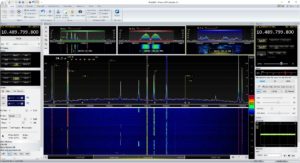# fw_setenv attr_name compatible
# fw_setenv attr_val ad9364
# fw_setenv maxcpus
# pluto_reboot reset
In the next step, I removed the board from the plastic housing and made the recommended connection (using a wire) of the USB connector cases with the GND point. Then I mounted the board in a metal housing and made connections to the PTT board: ground, + 5V (pad of unsoldered capacitor C185), GPIO0 and GPIO1. I connected the 40 MHz signal from the Pluto-clocker board to the appropriate IPEX socket (see below).
To switch the source of the 40 MHz signal generator from internal to external, enter the command (after starting PuTTY or a similar terminal):
# fw_setenv refclk_source external
After restarting Pluto, I launched SDR Console – the screen showed characteristic peaks from the QO-100 satellite, but shifted upwards by about 9.6 kHz.
After downloading PlutoDVB perseverance firmware 0303: pluto.zip (26.6M) and the patch PlutoDVB Patch Detection Hardware Revision firmware perseverance 0303.zip – you need to unpack them. To install the new firmware, copy the pluto.frm file to the Adalm-Pluto disk. Then perform the operation “- Eject PlutoSDR (X :)”. It’s about the drive, not the entire device! The LED on the left side of Pluto starts flashing rapidly. Wait a few minutes until it returns to normal. The USB cable must not be disconnected during the update! Adalm-Pluto will appear in Windows as PlutoSDR (X :). Please run info.html – Let’s go to PlutoDVB (on USB connection) – Main mode selection: Passthrough (SDR Console,…) – Apply Settings.
To install the above-mentioned patches, click System – Maintenance, find the folder with unpacked files PlutoDVB Patch Detection Hardware Revision firmware perseverance 0303, and click: Upload. After loading is complete, select: Reboot the Pluto.
If the frequency shift problem in the SDR Console described above stil exist, try:
– reinstalling the firmware version “perseverance 0303”
– remove old patches in Adalm-Pluto (System-Maintenance…)
– install the latest patch F5EOE PlutoDVB-Patch-Detection-Hardware-Revision-firmware-perseverance-0303-v2022-08-21.zip
– running (just in case) “hack” modifications
– # fw_setenv refclk_source external
– # fw_setenv ad936x_ext_refclk_override ‘<40000000>’
As a result, Pluto with SDR Console should work as it should, with the following settings: RX Offset 9.750.000.000 TX Offset 8.089.500.000. Even after the Pluto reset.
Miro SP5GNI



Leave a Comment